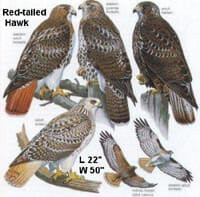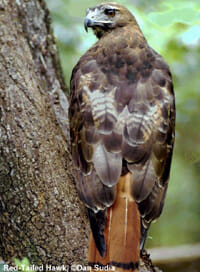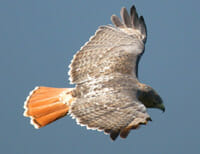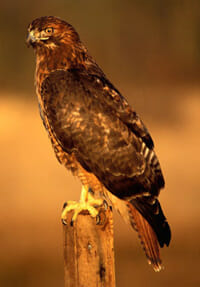Red-tailed Hawk – Falconiformes Accipitridae Buteo jamaicensis
 |
 |
 |
 |
Identification & Description:
• Large hawk.
• Short, dark, hooked beak
• Large, broad-winged, broad-tailed hawk
• Immatures have notably narrower wings and tail, and appear slimmer
• Dark patagial mark on underwing, present on all ages and races, is unique
• Blocky translucent area in outer primaries
• Flies with a dihedral
• Extraordinary geographic variation
• Wings long and broad.
• Sexes similar
• Most commonly with pale chest and dark band across belly.
• Size: 45-65 cm (18-26 in)
• Wingspan: 114-133 cm (45-52 in)
• Weight: 690-1460 g (24.36-51.54 ounces)
Light morph adult:
• Brown head, nape, back, and upperwings
• White chin, throat, breast, and belly
• Dark belly band formed by vertical streaks in band across belly
• White underwings have dark carpal bar on leading edge, dark outer primary tips and a dark trailing edge and are otherwise pale with dark bars on the flight feathers on all but the outermost primaries
• Tail appears brick red above and pink below
• Breast and back pattern vary with geography, with some birds being intermediate between light and dark morphs
Light morph immature:
• Like adult, but with less distinct markings below, and brown tail with numerous narrow, dark bands
Dark morph adult:
• Wholly dark chocolate underparts, upperparts and underwing coverts with no apparent patagial mark
• Pale underside to primaries and secondaries like light morph birds being pale with dark tips and dark bars on the flight feathers
• Tail appears brick red above and pink below (like light morph adult)
• Breast and back pattern vary with geography, with some birds being intermediate between light and dark morphs
Dark morph immature:
• Dark brown head, neck, breast, back, upperwing and underwing coverts are variably mottled with white and buff
• Dark brown tail with numerous darker bars
• Paler flight feathers with dark barring on all but the outermost primaries
Harlan’s Hawk adult:
• Recently split
• Entirely blackish body plumage
• White necklace of streaks across breast
• Tail variably pale gray, gray, or reddish, with dark terminal band
Harlan’s Hawk immature:
• Entirely blackish body plumage
• Flight feathers extensively barred below (including outermost primaries)
• Tail pale with numerous dark bars
Krider’s Hawk adult:
• Paler head and back than Eastern adult
• Tail varies from pink to white
• Belly band and patagial mark faint or absent
Krider’s Hawk immature:
• like Krider’s adult, but with whitish tail with several dark bands and whitish primaries without barring
Fuerte’s Hawk
• Like Eastern adult but lacks belly band and is darker on the back and upperwing coverts
Similar species:
Red tail, patagial mark and belly band diagnostic when present. Due to its extreme variability though, the Red-tailed Hawk can be very difficult to identify. Most other light morph buteos are separable by shape and plumage, with Ferruginous Hawk being the most similar. The adult Ferruginous can be identified by its lack of a belly band, rufous leggings, paler flight feathers, lack of a patagial mark, and extensive reddish coloration on the upperwing coverts. The immature Ferruginous is similar to the immature Red-tailed but lacks the dark patagial mark. Dark morph Swainson’s has dark flight feathers and white undertail coverts. Rough-legged has unmarked flight feathers and a white comma in the outermost underwing coverts. Other dark morph buteos (Broad-winged, Short-tailed) are smaller with different flight profiles. Immature White-tailed Hawk has a white diamond on its central breast.
Life History Groupings
• Migration Status: Short distance migrant
• Clutch Size: 1-3
• Length of Incubation: 30-35 days
• Days to Fledge: 45-46
• Number of Broods: 1?
• Diet:
Primarily: Small Mammals
Lesser Quantities of: Reptiles or Amphibians & Birds
Facts
• The “Harlan’s Hawk” was once considered a separate species. It breeds in Alaska and northwestern Canada, and winters on the southern Great Plains. This very dark form has a marbled white, brown, and gray tail instead of a red one. Many individuals intermediate between Harlan’s and more typical Red-tailed Hawks can be found.
• The raspy cry of the Red-tailed Hawk is used in movies to represent any eagle or hawk anywhere in the world.
• In the courtship display a pair of Red-tailed Hawks soars in wide circles at a great height. The male dives down in a steep drop, then shoots up again at nearly as steep an angle. He repeats this maneuver several times, then approaches the female from above. He extends his legs and touches or grasps her briefly. The pair may grab onto one other and may interlock their talons and spiral toward the ground.
Other Names
Buse à queue rousse (French)
Aguililla parda (Spanish)
The red-tailed hawk is a member of the hawk family Accipitridae, in the order Falconiformes, and is classified as Buteo jamaicensis.
Red-Tailed Hawk, common name for the most abundant and familiar hawk in North America. It lives from Alaska and Canada south through Panama and is found in a variety of habitats with open ground and high perches.
The red-tailed hawk measures 48 to 63 cm (19 to 25 in) in length with a wingspread of about 127 cm (about 50 in). The plumage varies greatly between different races from almost black to very pale brown, but all adults have a characteristic reddish-brown tail. Typically, the plumage is brown on the head, back, and wings with light buff underparts. The male and female are similar in appearance except that the female is slightly larger. The juvenile looks similar to adults except that it lacks the red tail. Generally the juvenile takes three years to develop adult plumage. The red-tailed hawk’s cry is a shrieking keeer.
The red-tailed hawk eats small mammals, especially rodents, and also birds, snakes, and large insects. It hunts by gliding over open countryside searching for prey. Once the prey is spotted, the hawk dives to a lower elevation and hovers over it. When the hawk is ready, it folds its wings, drops, and grabs the prey with its sharp talons. It may also watch for prey from a high perch.
During courtship, the male and female soar in high circles while making shrill cries. After the pair have bonded, they build a large bulky nest out of sticks and line it with finer materials. The nest is usually built in the top of a tall tree, up to 37 m (up to 120 ft) above the ground. They take turns incubating, or warming, the two or three whitish eggs by sitting on them for 28 to 35 days. The newly hatched young are fed by both parents and usually leave the nest within 45 days of hatching. Red-tailed hawks have been known to enlist other adult red-tailed hawks to help with the care of the young.: